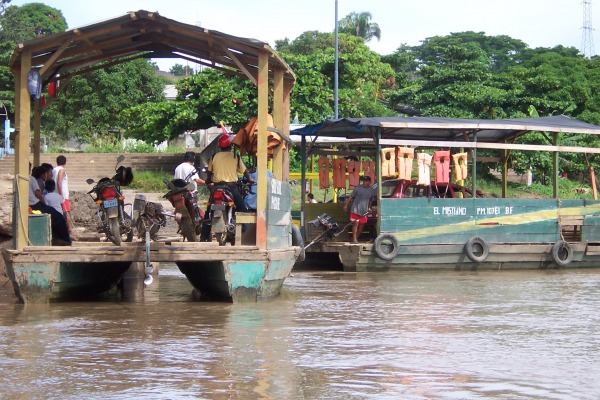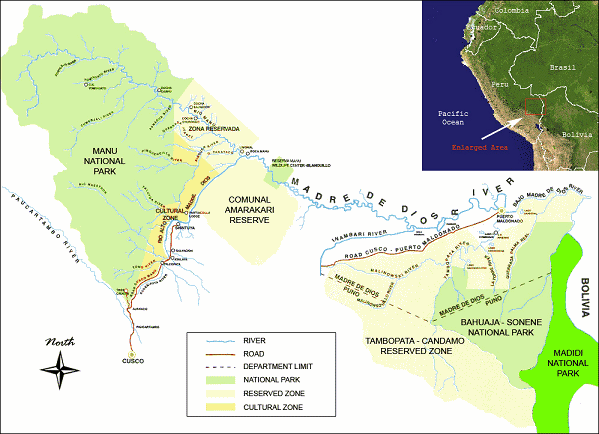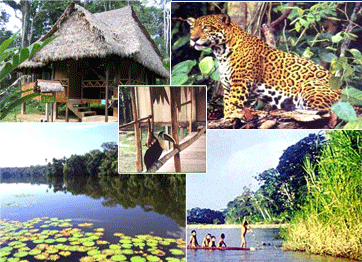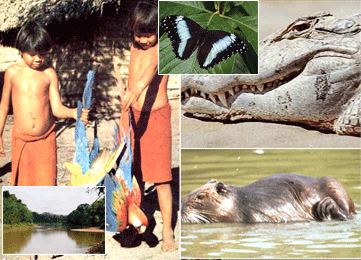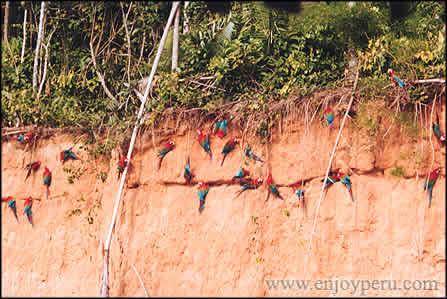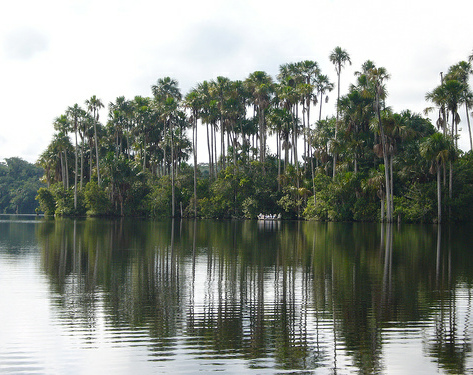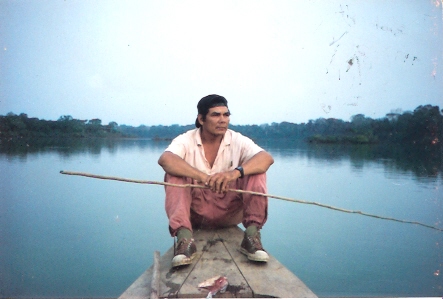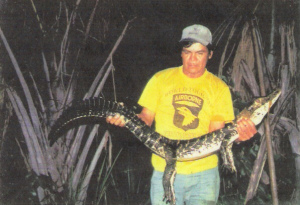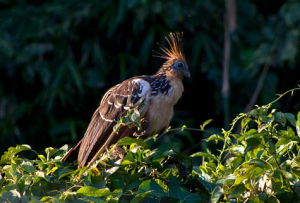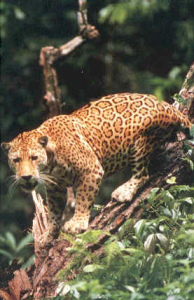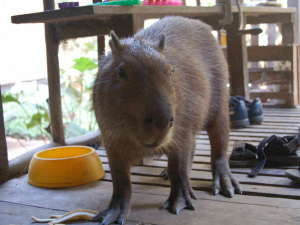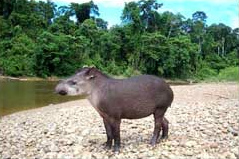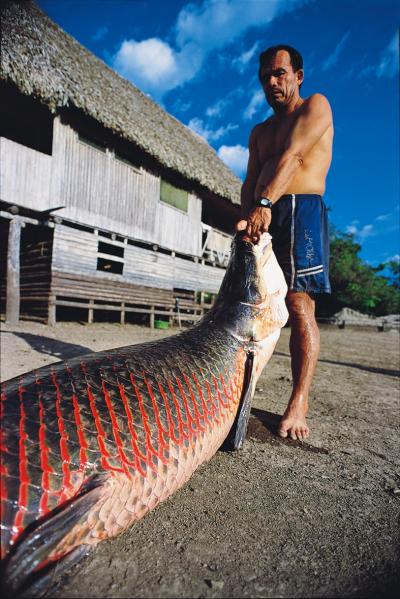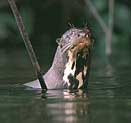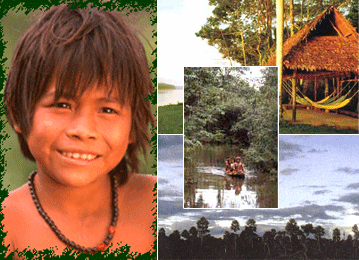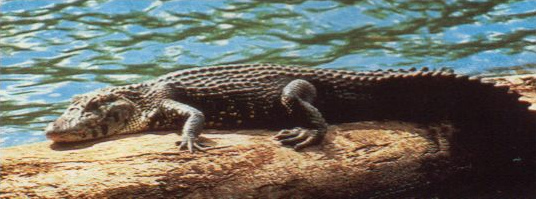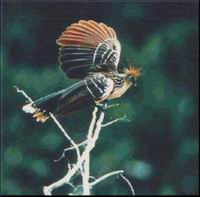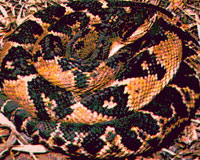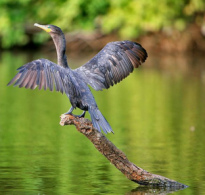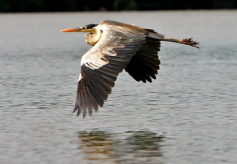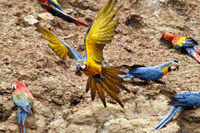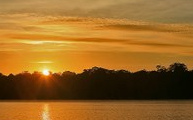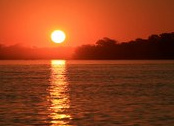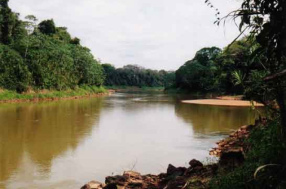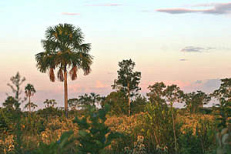

Peruvian Southern jungle 03: Natural reserves and excursions in Madre de Dios department around Puerto Maldonado
National parks and reservations around Puerto Maldonado - trips organized by yourself or by operators - and the lodges
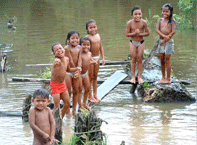
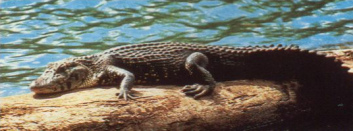
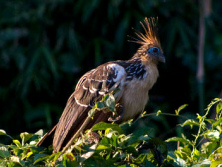
presented by Michael Palomino (2008)
| Share / teilen: |
Facebook |
|
Twitter
|
|
|
|
from: Dilwyn Jenkins: The rough guide to Peru; Rough Guides, New York, London, Delhi; 6th edition September 2006; www.roughguides.com
The jungle of the Madre de Dios department
Madre de Dios boasts spectacular virgin lowland rainforest and exceptional wildlife. Brazil-nut tree trails, a range of lodges, some excellent local guides and ecologists, plus indigenous and colonist cultures are all within a few hours of Puerto Maldonado. Serious jungle trips can be made here with relative ease and without too much expense, and this part of the Amazon offers easy and uniquely rewarding access to rainforest that is much less disturbed than that around Iquitos, or Manaus in the heart of the Brazilian Amazon, for example (p.550).
Bus connections from Puerto Maldonado to the surrounding region
There are two main routes out of Puerto Maldonado: Avenida Fitzcarraldo brings you out at the cattle ranches on the far side of the airstrip; while if you turn off on [Jirón] 28 de Julio, you can take the road as far as you like in the direction of Laberinto, Quincemil and Cusco. A regular bus and colectivo ($5) service now connects Puerto Maldonado with Laberinto (leaving from the Hotel Wilson, or from the main market on [Jirón] Ernesto Rivero), some ninety minutes away. Formerly a gold-mining frontier settlement, since the early 1990s it has been surpassed in importance by the settlement of Masuko, deeper into the forest, and is now important mainly for its role as an upriver port for Puerto Maldonado; most boats going upstream start here, though if you're planning to visit Manu Biosphere Reserve, you should set out from Cusco (p.545).
Boat connections from Puerto Maldonado to the surrounding region
Port of Puerto Maldonado with ferries with swim wests
There are two main ways to explore: firstly, by arranging your own boat and boatman; and secondly, though considerably more expensive, by taking an excursion up to one of the lodges (p.550).
Puerto Maldonado has two main river ports, one on the Río Tambopata, at the southern end of León de Velarde, the main street, the other on the Río Madre de Dios, at the northern end of León de Velarde; from the former, there's a very cheap ferry service across the river to the newish road to Brazil (p.546).
From either it's possible to hire a boatman and canoe for a river trip; prices usually start at $25 per person for a day journey, for a minimum of two people; this rises to $35 for (p.546)
trips of two to four days. Boats are equipped with a peque-peque or small outboard motor, and usually take up to twelve people. If you're prepared to pay significantly more (from $100 a day per person, again for a minimum of two), you can find boatmen with speedboats and larger outboard motors (p.547).
The natural reserves around Puerto Maldonado
Yet, while the department's scattered towns and villages are interesting for their Wild West energy and spirit, most visitors come for the wildlife, especially in the strictly protected Manu Biosphere Reserve - still essentially an expedition zone - and the cheaper, less well-known Tambopata-Candamo Reserved Zone, chiefly visited by groups staying at lodges;
between them these areas encompass some of the most exciting jungle and richest flora and fauna in the world.
Tambopata Candamo National Park with lodge, lakes, birds, jaguars, and natives on a float (raft)
The newest protected area is Bahuaja-Sonene National Park; created in 2000 and surrounded largely by a massive rainforest area formed by Tambopata, it is intended to show the Peruvian government's support for this region as an ecological treasure. Taken together, these three zones comprise some 1.5 million hectares, almost the size of Manu (15,000 square kilometers),
Bahuaja-Sonene National Park with natives with a macaw, a lake, a crocodile and a capybara
and if you add on the Madidi National Park - just across the border in Bolivia - the protected area in this corner of the Amazon exceeds 50,000 square kilometers.
As in all jungle regions, human activity here is closely linked to the river system, and Manu and Tambopata are actually among the most easily reached parts of the Amazon: from Cusco, Manu is either a day's journey by bus then a couple days more by canoe, or a thirty-minute flight in a light aircraft; Tambopata, meanwhile, is a forty-minute scheduled flight (or 3- to 10-day truck journey), plus a few hours in a motorized canoe (p.542).
The Tambopata-Candamo reserved zone
Arguably containing some of the world's finest and most biodiverse rainforest, the Tambopata-Candamo Reserved Zone ($30 entry fee) is accessible from many of the lodges in the Puerto Maldonado region. Initially an area of less than 6000 hectares, it was transformed into a Reserved Zone, mainly due to the scientific work of the adjacent Explorer's Inn lodge. In 1990, after further studies had proved the value of the forest in terms of biodiversity conservation, the reserved sector was expanded to almost 1.5 million hectares. In 2000 the Bahuaja-Sonene National Park was enlarged, and incorporated almost 250,000 hectares of the original Tambopata-Candamo Reserved Zone.
It's not possible to visit the National Park, except for licensed operators coming down from the Alto Tambopata on rafting expeditions or on tours to one of the major macaw colpas (salt-licks) in the region.
Macaws on a clay cliff (colpa) on Tambopata river
Like most licks, they attract wild birds and animals because they offer the salts, minerals and clay required for their nutrition and also function as digestive aids for these creatures. Although reducing the Tambopata-Candamo Reserved Zone, the expansion of the National Park is something of a major success for conservation in Peru. For more details, contact TReeS (c/o John Forrest, Tambopata Reserve Society, PO Box 33153, London NW3 4DR, UK), a UK organization with strong links with the Tambopata area; they should be able to offer you detailed and up-to-date information on the situation and the environmental work going on there. They can also advise you about many of the lodges (p.556).
Independent excursions around Puerto Maldonado
Permission needed - the jungle offices
Tour agencies: Turismo de los Angeles, Jirón Puno 657, Puerto Maldonado, T. 082-571070 (p.549).
Traveling independently can be rewarding [enriching], though note that most of the major river trips (including Lago Valencia) require visitors to obtain permission from the Captain's Office in Puerto Maldonado - though boatmen and guides generally do this and also organize payment of entry fees for you at the INRENA office
-- in Puerto Maldonado: Dirección Sub-regional Agraria Madre de Dios, Avenida (p.555) 28 de Julio 482, Puerto Maldonado
-- in Lima: Calle 17, 335 Urba. El Palomar, San Isidro, Lima, T. 01-224-3298, e-mail: comunicaciones@inrea.gob.pe
Even if you do end up doing this yourself it's normally quite straightforward, though it can be a battle to be heard over the chicha music on the captain's radio (p.556).
Find the right boatman and a guide
Fortunately, it's still possible to get your own expedition together without spending a fortune. For limited excursions all you need is a boat and boatman, permission from the Captain's Office and basic essentials. One of the most important aspects of any boat trip is finding the right boatman: three recommended guides include the pretty reliable and well-organized
Willy Wither; who has lived in the area for many years and goes to a wide range of places by canoe and on foot (he usually meets flights at Puerto Maldonado airport and speaks mainly Spanish);
Javier Salazar, who owns the Hotel Iñapari and often takes groups up the Río de las Piedras and guides in English, Spanish or French;
and Romel Nacimiento, a boat-owner and guide who specializes in day-trips to Lago Sandoval, and who can usually be found at the Madre de Dios river port (ask around to find out where he is).
Alternatively, ask around town or go down to the port to speak to a few of the guys who have canoes and motors. If there are six or more of you, these do-it-yourself trips (always go with a guide) can cost under $25 a day per person, all-inclusive; expect to pay between $50 and $120 a day for a reasonable launch (big enough for eight), with a decent outboard motor, a guide-cum-boatman, and fuel. All guides should have a Ministerio de Turismo carnet (ID card) (p.556)
Lago Sandoval and Lago Valencia: piranhas, paiche fish, birds, otters - the Fitzcarrald wreckage is a hospital wreckage
Map of the Puerto Maldonado region with lakes, rivers and lodges: Lago Sandoval, Lago Valencia, Lago Sachavacayoc, rivers and reservation zone
Slightly less accessible than the protected zones, but nevertheless offering travelers staying in Puerto Maldonado a taste of the rainforest, are Lago Sandoval and the huge expanse of Lago Valencia,
Sandoval Lake (Lago Sandoval) in the region of Puerto Maldonado
Valencia Lake (Lago Valencia) in the region of Puerto Maldonado
Valencia Lake (Lago Valencia), native children
both great wildlife locales east along the Río Madre de Dios and close to the Bolivian border. At the least, you're likely to spot a few caimans and the strange hoatzin birds, and if you're lucky, larger mammals such as capybara, tapir, or, less likely, a jaguar - and at Valencia [Lake], you can fish for piranha (p.543).
Less than one hour downriver from Puerto Maldonado (90min on the return upriver) is Lago Sandoval, a large lake where the Ministry of Agriculture have introduced the large paiche fish. At its best on weekday mornings (it gets quite crowded at other times), there are decent opportunities for spotting wildlife, in particular birds similar to those at Lago Valencia. You may even spot a giant otter (Pteronura brasilensis).
Paiche fish in the Puerto Maldonado region
Giant otter in Sandoval lake (Lago Sandoval)
It's also possible to walk to the lake [Sandoval] (about 1hr), and once here boatmen and canoes can usually be obtained by your guide for a couple of hours, as can food and drink.
Incidentally, if you're traveling to the lake by river, most guides will show you the ruined hulk of an old boat lying close to the riverbank. If they claim it had anything to do with Fitzcarrald, don't believe them; it may be similar in style to Fitzcarrald's, but in fact it's smaller and is a far more recent arrival - it's a hospital boat that was in use until two or three decades ago (p.550).
Excursion to Valencia lake: gold panners, Ese Eja native village - animals of the lake - passport control on the lake
Lago Valencia: It takes the best part of a day by canoe with a peque-peque, or around two hours in a lancha with an outboard, to reach the huge lake of Lago Valencia from Puerto Maldonado. On the way you can stop off to watch some gold-panners on the Madre de Dios [river] and visit a small settlement of Ese Eja Indians;
Ese Eja natives in the Puerto Maldonado region
about (p.550)
thirty minutes beyond, you turn off the main river into a narrow channel that connects with the [Valencia] lake. Easing onto the lake itself, the sounds of the canoe engine are totally silenced by the weight and expanse of water. Towards sunset it's quite common to see caimans basking on the muddy banks, an occasional puma, or the largest rodent in the world, a capybara, scuttling away into the forest. Up in the trees around the channel lie hundreds of hoatzin birds, or gallos as they are called locally - large, ungainly creatures with orange and brown plumage, long wings and distinctive spiky crests. The strangest feature of the hoatzin is the claws at the end of their wings, which they use to help them climb up into overhanging branches beside rivers and lakes. They have almost lost the power of flight.
Animals of the Puerto Maldonado region
Caiman at Sandoval Lake on a wooden trunk
Puma / mountain lion
A capybara leaving the water
Hoatzin bird in Wasai
There's a police control post on the right as you come out onto the lake, where you must register passports and show your port captain's permit.
Settlement on Sandoval lake - walk in the forest: plants and liquids (vines) of plants and trees
Beyond, reached via a slippery path above a group of dugout canoes (p.551),
is the lake's one real settlement, a cluster of thatched huts around a slightly larger schoolhouse. Fewer than fifty people live here - a schoolteacher, a lay priest, the shop owner, and a few fishing families. Some tour groups stay in a small camp further down, a seasonal nut-collectors' campamento, comprising just one cooking hut with an adjacent sleeping platform.
By day most people go for a walk in the forest - something that's both safer and more interesting with a guide, though whichever way you do it you'll immediately sense the energy and abundance of life. Quinine trees [Span. chinchona] tower above all the trails, surpassed only by the Tahuari hardwoods, trees so tall and solid that jungle shamans compare themselves according to power. Around their trunks you'll often see pega-pega, a parasitic ivy-like plant that the shamans mix with the hallucinogenic ayahuasca into an intense aphrodisiac.
Perhaps more useful are the liana vines; one thin species dangling above the paths can be used to take away the pain from a shushupe snake-bite.
Shushupe snake (Lachesis muta)
Another, the maravilla or palo de agua ["water stick"] issues a cool stream of fresh water if you chop a section, about half a meter long, and put it to your lips. You may come upon another vine, too - the sinister matapalo (or renaco), which sometimes extends over dozens of trees, sucking the sap from up to a square kilometer of jungle.
Fishing on Valencia lake - caimans - the night on the lake with night eyes of the caimans
You can also take a canoe up the lake fur a bit of fishing, passing beaches studded with groups of lazy-looking turtles sunning themselves in line along the top of fallen tree trunks - when they notice the canoe, each one topless off, slowly splashing into the water one after another. It takes a bit more to frighten the white caimans away; many can be seen soaking in the sun's strong rays along the margin of the lake. Sometimes over 2m in length, they're a daunting [frightening] sight, although they won't bite unless you happen to step on one.
The easiest fish to catch are piranha - all you need is some line, a hook, and a chunk of unsalted meat; throw this into the lake and you've got yourself a piranha.
Yellow-bellied piranha
At night, it's possible to glide along the water, keeping close to the bank, looking for the amber glint reflected from a pair of caiman eyes as the beam from your torch catches them. This is how the locals hunt them, fixing the crocs [crocodiles] with a beam of light, then moving closer before blasting them with a shotgun; unless you're really hungry (the meat is something of a delicacy), it's best just to look int their gleaming eyes in the pitch darkness. The only sound on the lake will be the grunting of corvina fish vibrating up through the bottom of the canoe (p.552).
Bird watching and more animals on Lake Valencia and Lake Sandoval
Both - Lago Valencia and Lago Sandoval - are superbly endowed with birdlife. In addition to the hoatzin there are kingfishers, cormorants, herons, egrets, pink flamingos, skimmers, macaws, toucans, parrots and gavilans. And behind the wall of trees along the banks hide deer, wild pigs and tapir.
Birds of Sandoval Lake region
Cormorant at Sandoval Lake
Heron at Sandoval Lake
Macaws in Tambopata reservation
Sunrise at Sandoval Lake
Sunset at Sandoval Lake
If you're lucky enough to catch a glimpse of a tapir you'll be seeing one of South America's strangest creatures - almost the size of a cow, with an elongated rubbery nose and spiky mane. In fact, the tapir is known in the jungle as a sachavaca ("forest cow" - sacha is Quechua for "forest" and vaca is Spanish for "cow") (p.552).
Excursion: Río Heath - grassland Pampas del Heath
Heath river
Pampas del Heath
[Heath river is the border river between Perú and Bolivia].
Another good trip, if you've got at least three days to spare (two nights minimum), is up to the Río Heath, a national rainforest sanctuary, though while the Pampas del Heath are excellent for watching macaws they don't have the primary forest necessary for a great variety of wildlife (p.552).
Las Pampas del Heath are the only tropical grassland within Peru. It now lies within the Bahuaja-Sonene National Park, so special permission is needed from the INRENA OFFICE to (p.543) visit it. The grasslands extend eastward across northern Bolivia to the Pantanal region of Brazil, itself one of the wildlife gems [highlight] of the Americas (p.544).
[Pantanal region of Brazil is one of the biggest marshal region on earth
(http://de.wikipedia.org/wiki/Pantanal)].
Excursion: Tres Chimbales - Infierno native village
A shorter trip - five hours up and about two hours down the Río Tambopata - is to Tres Chimbales [Lake], where there are a few houses belonging to the Infierno community on the Río Tambopata; it's possible to spend two or three days watching for wildlife, walking in the forest and fishing. From here you can visit Infierno village itself, spread out along the river, peppered with thatched and tin-roofed huts.
Excursion to Bolivia
One other possibility, though something not commonly done by gringos [green go], is to travel into Bolivia on one of the cargo boats that leave more or less (p.552)
every week from Puerto Maldonado. Before embarking on this, however, you'll have to clear your passport and visa with the Puerto Maldonado police and Migraciones offices. Puerto Pardo is the last Peruvian frontier settlement (Bolivian formalities can usually be dealt with at the frontier post of Puerto Heath, from where you continue by river to Riberalta). Be aware that the journey from Puerto Maldonado to Riberalta is rough and usually takes ten to fourteen days; always make sure that the boat is going all the way or you might get stuck at the border, which, by all accounts, is not much fun, and you might have to wait days for another boat. From Riberalta there are land and air connections to the rest of Bolivia, as well as river or road access into Brazil via the Río Madeira or [the Brazil village] Guajara-Mirim (p.553).
Río Tambopata and Río Tavara
Whichever way you organize it, if you have the opportunity to spend several days exploring the Río Tambopata, try and get up as far as the mouth of the Río Tavara, where the wildlife is still abundant. No colonos have ever settled this far upstream and the jungle is wild, though not totally virgin - when Colonel Fawcett (a British explorer who vanished in the Amazon in the early twentieth century on a quixotic search for an ancient city he had heard about from the Indians) came through here, rubber extraction was already going on and a mule track running from Puno down the Tavara Valley had been established (p.556).
Lago Otorongo - the life of the giant otters
The giant otters of Lago Otorongo are one of the world's most endangered species, and contact with people has to be minimized for their safety and long-term conservation. They are also bio-indicators of the environment, since they only live where there is clean, healthy water and a wide choice of fish, so conservation of this rainforest environment is of primary importance. Only the oldest female of the group is mated with, so reproduction is very slow - the "queen" otters only have two or three cubs a year, usually around October, which can be expected to live for around thirty years. The top-ranking male otters are responsible for defending the group and do very little fishing, taking the catch from younger males instead.
Although they appear friendly as they play in their large family groups, they can be very aggressive, able to keep jaguars at bay and kill caimans who approach their lakeside nesting holes, which they mark by mixing male urine with clay at the entrance (p.557).
Organized tours around Puerto Maldonado: Operators and jungle packages
Organize the jungle package in advance
Compared to independent travel, an organized excursion saves time and adds varying degrees of comfort. It also ensures that you go with someone who knows the area, probably speaks English, and, if you choose well, can introduce you to the flora, fauna and culture of the region. It's also worth noting that you are less likely to get ripped off [betrayed] with a registered company with a fixed office and contact details, especially if you should need redress afterwards.
Most people book a trip in Cusco before traveling to Puerto Maldonado, though it is possible to contact most of the operators in Puerto Maldonado itself, either at the airport or through one of the offices, or through the cafés on [Jirón] León de Velarde.
Flying from Cusco is the quickest way to reach Puerto Maldonado, and most Cusco agencies will organize plane tickets ($40-50) for you if you take their tours. It's possible to buy a jungle package that does not include the airfare; this can work to your advantage, especially if you're able to secure one of the discounted air tickets (to as low as $29 from the standard $59 each way) from Cusco to Puerto Maldonado. The cheapest option is a two-day and one-night tour of the Puerto Maldonado area, but on these you can expect to spend most of your time traveling and sleeping. Frankly, the Amazon deserves a longer visit, and you're only looking at $25-50 more for an extra day.
Of the ever-increasing number of lodges and tour operators around Puerto Maldonado, mainly on the Ríos Madre de Dios and Tambopata, all offer a good taste of the jungle, but the quality of the experience varies from area to area and lodge to lodge - all lodges tend to offer full board and include transfers, though always check the level of service and ask to see photos at the lodges' offices in Cusco or Lima (p.553).
Food prices - lodges construction - daily rhythm of a lodge
It's also worth checking out what costs will be once you're there; complaints are common about the price of drinks, although given the distance they've traveled, the mark-up [price increase] is hardly surprising.
Remember, too, that even the most luxurious place is far removed from normal conveniences, and conditions tend to be rustic and relatively open to the elements. Varying in capacity (the largest can accommodate up to a hundred, the smaller no more than a dozen or so), most lodges have huts, cabins or bungalows built from wood and palm fronds gathered from the forest. Toilets can be anything from standard WC, covered in mosquito netting to earth privies, while sleeping arrangements can range from bunk rooms to pretty comfy twin doubles with doors and mosquito-net windows.
Food is generally good, though you might want to take supplements or treats. Note that most lodges require guests to get up very early in the morning on the day of departure in order to arrive at Puerto Maldonado airport in good time - generally speaking, the nearer the lodge to the town, the longer you can sleep in (p.553).
It's a good idea to shop around before arriving: that way you can spend time getting a feel of what's available. Otherwise, you can just walk up [Jirón] Plateros, [Jirón] Saphi (p.553)
and [Jirón] Procuradores, or around the Plaza de Armas, in Cusco and you'll find most of their offices. Many of the longer, more established companies have their offices out of the center. It's worth checking what deals are on at the time with all of the airline companies.
Lodges and operators of jungle tours around Puerto Maldonado
Map of the Puerto Maldonado region with lakes, rivers and lodges: Lago Sandoval, Lago Valencia, Lago Sachavacayoc, rivers and reservation zone
Bahuaja Research Center: simple lodge - rain forest excursions - Greenforce
Puerto Maldonado: T./Fax 082-573348
A small lodge aimed at the less wealthy traveler. It's fairly basic - toilets and showers are shared - but has a pleasant setting. Visits go to Tres Chimbales and Lago Sachavacayoc, with guided tours in English and Spanish, plus there are extensive trails in the surrounding forest. The research side of the operation is associated with the UK organization Greenforce. From $165 per person for 4 days and 3 nights.
Buenaventura Casa de Hospedaje: familiar home, chacra gardens - rain forest excursions - waterfall excursion, Chucho colpa excursion
Puerto Maldonado: T. 082-572590, e-mail: jerko_herrera@exite.com.pe
Located in the community of Baltimore, 4hr upriver from Puerto Maldonado (6-7hr by peque-peque). Adjoining a family home and chacra gardens, this is a good but bare-bones place, with shared toilets and showers. The trail system is quite limited, but trips go to the nearby waterfall and Chuncho colpa (guides speak Spanish only). $20 per day per person full board, $15 without.
Casa Machiguenga: native and NGO run lodge
contactable through Manu Expeditions
Owned by the Machiguenga Indian communities of Tayakome and Yombebato, though run by a German NGO as the Machiguenga are still undergoing a capacity-building program. It's pretty rustic, with accommodation in huts, though with modern conveniences such as hot water and showers available; $35-45 per night per person.
Cusco Amazonico Lodge: own rain forest, monkey island - Sandoval Lake excursion
in Cusco: Pasaje J.C. Tello C-13, Urbanización Santa Monica, Cusco, T. 084-235314, e-mail: koechlin@inkaterra.com.pe;
in Lima: T. 01-4226574, Fax 4226574, e-mail: reservas@inkaterra.com.pe
Set up by a French-Peruvian venture in 1975, comforts here include a cocktail bar and good food (often a buffet). The main excursion is to Lago Sandoval, some 20min upriver, and guides speak several languages. The lodge owns 10,000 hectares of forest surrounding it and has recently established a monkey island. From $160 per person for 3 days and 2 nights ($25 supplement for a single).
Eco Amazonia Lodge: birdwatching, swamp-forest, tree-canopy access - Sandoval Lake excursion, Palma Real natives excursion
in Cusco: Portal de Panes 109, Oficina 6, Cusco, T. 084-236159, Fax 225068, e-mail: ecolodge@chasqui.unsaac.edu.pe
in Lima: Avenida Larco 1083, Oficina 408, Miraflores, Lima, T./Fax 01-2422708
Less than two hours downriver of Puerto Maldonado, this large establishment offers basic bungalows and dormitories. The area abounds in stunning oxbow lakes but can't claim the variety of flora and fauna of the Tambopata-Candamo Reserved Zone, however it is recommended for birdwatching, plus it has swamp-forest platforms and is the only lodge in the area with tree-canopy access. Packages usually include visits to Lago Sandoval, about 30min upriver, plus organized visits can be made to the Palma Real community (though this is often anticlimactic [disappointing] and of dubious value to both tribe and tourist) and a monkey island. From $40-60 per person per night according to length of stay.
Explorandes: rafting from Puno to Puerto Maldonado
in Lima: [Jirón] San Fernando 320, Miraflores, Lima, T.. 01-4450532, Fax 4454686, e-mail: Postmast@Exploran.com.pe
A veteran company operating whitewater rafting expeditions, including a 12-day trip starting out from Puno by road, then traveling down through cloud forest, and finally rafting through class 3 to 5 rapids [chutes, riffles] along the Río Tambopata to Puerto Maldonado, where the last night is spent in a lodge. $1495 per person, for a minimum of four people.
Explorer's Inn: in the Tambopata-Candamo reserve
in Cusco: [Jirón] Plateros 365, Cusco, T. 084-235342
in Lima: Peruvian Safaris Lima office, [Jirón] Alcanfores 459, Miraflores, Lima, T. 01-447888 or 4474761, Fax 2418427, e-mail: safaris@amauta.rcp.net.pe, www.peruviansafaris.com
in Puerto Maldonado: Avenida Fitzcarrald 136, T. 082-572078
In the Tambopata-Candamo Reserved Zone, 58km (about 3hr) in a motorized canoe upriver from Puerto Maldonado, this is a large, well-organized lodge where research has contributed towards building a world-record list of species (580 birds and 1230 butterflies). Spanish- or English-speaking guides are available (boots are provided for jungle walks), and there are excellent displays, mostly in English, about rainforest ecology, plus there are radio links to the outside world.
Food is good, and accommodation is generally in twin rooms with private bath. Full board is included. The price includes airport transfers with expeditions to a nearby macaw salt lick (colpa) - generally requiring one night camping out - plus there's a superb network of well-marked jungle trails. From $180 per person for 3 days and nights; inquire about rates for special-interest visitors (e.g. omithologists).
Iñapari Amazon Adventures: safaris in the Piedras river region
in Cusco: c/o Solo Selva, [Jirón] Plateros 364, Cusco, T. 084-228590, Fax 247259, www.soloselva.com
This outfit uses native guides and offers quite rough but well-organized and adventurous safaris in the Río de las Piedras region, as well as other rivers on request. In the (p.554)
Piedras they frequently visit the Río Pariamanu, Lago Lucerna, a macaw clay-lick. Prices start at around $160 for 3 nights and $310 for 5.
Inotawa Expeditions: near Bahuaja-Sonene National Park - expeditions to Colpa Colorado
-- in Puerto Maldonado: [Jirón] Fonavi J9, Puerto Maldonado (daily 9-11am & 4-5pm), T. 082-572511
-- in Lima: 01-4674560, www.inotawaexeditions.com
Located on the Río Tambopata quite close to the start of the Bahuaja-Sonene National Park, they have a nice lodge in a good location, and offer expeditions to Colpa Colorado, a macaw and animal salt-lick a further 8 hours into the forest from their lodge. Prices start at around $150 for 3 days / two nights and $400 for 5 nights, but the minimum group required is 6.
Mejia Lodge: on Lago Sandoval - lake expeditions
T. 082-571428
On the shores of the popular Lago Sandoval, this rustic-style lodge is perfect for canoe exploration of the lake. It's rarely full, so it's fine to just turn up here by canoe from Puerto Maldonado without prior arrangement (get the boatman to drop you off on the trail). One of two lodges on the lake, this is an expanded family home with ten doubles and basic, shared toilet facilities. $15-$20 per person per day (dependent on season and open to negotiation), including food.
Picaflor Research Center: familiar lodge on Tambopata River - volunteer programs
e-mail: picaflor_rc@yahoo.com, www.picaflor.org
Located on the Tambopata River some 78km from Puerto Maldonado, this place is run by British woman, Laurel Hanna, and her family. Picaflor is relatively new and has its own volunteer program as well as offering research and tourism stays.
Posada Amazonas Lodge and Tambopata Research Center: run by Ese Eja natives - bird habitats and other animals - excursion to Tres Chimbadas lake - excursions to Tambopata macaw colpa
contact through Rainforest Expeditions, [Jirón] Aramburu 166, 4B, Lima 18, T. 01-4218347 or 2214182, Fax 4218183, www.perunature.com
This is probably the region's best lodge for its relationship with locals - it's owned by the Ese Eja community of Infierno (though mainly non-native members work here) - and for its wildlife research. There's great bird diversity in seven distinct, easily accessible habitats, plus good populations of primates and large mammals. Resident researchers act as guides (different languages available), and most packages include a visit to Lago Tres Chimbadas; additional trips to the Tambopata macaw colpa (6-8hr upriver) can be arranged, involving a night at the remote Tambopata Research Center (TRC); a minimum of 6 days is recommended for complete tours. The lodge itself features large, stylish doubles with shared bath, set in three native-style buildings, plus a central dining area / bar and lecture room. From $90 per day per person.
Sandoval Lodge
in Cusco: Avenida Sol 821, second floor, Cusco, T. 084-226392, e-mail: inkanatura@chavin.rcp.net.pe
in Lima: InkaNatura, [Jirón] Manuel Bañon 461, San Isidro, Lima, T. 01-4402022, www.inkanatura.com
On the shores of Lago Sandoval, and usually accessed by canoe, this is the only lodge offering regular trips to this zone. It's medium-sized and features one large communal building as a bar and dining room, plus it boasts electricity and hot water.
Most groups spend time on the lake or explore the small, well-trodden surrounding trail system, and there's also a small platform on the Río Heath. Guides speak several languages, including English. From $60-80 per person per day, depending on size of group, nature of visit and length of stay.
Tambopata Jungle Lodge
in Cusco: Avenida Pardo 705, Cusco, T. 084-225701, Fax 238911, www.tambopatalodge.com
Located in the Tambopata-Candamo Reserved Zone, 12km up the Río Tambopata from the Explorer's Inn, nearly 4hr from Puerto Maldonado. The lodge has comfortable, individual cabin-style accommodation and offers excellent tours of the forest, in Spanish and English. It's located quite close to a community of colonos, some of whom farm while others pan for gold. Trips include a visit to Lago Condenado and sometimes Lago Sandoval, plus the Chuncho colpa by arrangement. From $160 per person for 3 days / 2 nights.
Wasai Lodge: 15km trail excursions - Chuncho colpa excursion - Lago Sandoval excursion
-- in Puerto Maldonado: owned by the Wasai hotel in Puerto Maldonado, Calle Arequipa 242
-- in Cusco: through Solo Selva, [Jirón] Plateros 364, T. 084-228590, Fax 247259, www.soloselva.com
Four hours upriver from Puerto Maldonado this relatively new and smallish lodge is set in the forest, with a pleasant jungle bar and dining area. Spanish- and English-speaking guides are available, with 15km of trails in the vicinity plus trips to the Chuncho colpa on request. Usually from $340 per person for 4 days and 3 nights, but sometimes offered with promotional discounts at around $175; including a visit to Lago Sandoval plus the last night at the Wasai (avoiding the early morning start); $500 for 7 days / 6 nights, including a visit to the colpa (p.555).
| Share / teilen: |
Facebook |
|
Twitter
|
|
|
|
Picture sources
-- map of national parks Manu and in the Puerto Maldonado region:
http://www.biosci.missouri.edu/avianecology/kosnipata/index.html
-- map of the natural reserves around Puerto Maldonado: http://www.fertur-travel.com/tambopata_maps.html
-- map of Madidi National Park: http://www.andes-mesili.com/gb/prog-amazonie.htm
-- port of Puerto Maldonado: http://www.ballofdirt.com/entries/14054/233371.html
-- Bahuaja-Sonene National Park: http://www.serperuano.com/turismo/madre/areas_naturales.php
-- Tambopata-Candamo National Park: http://www.serperuano.com/turismo/madre/areas_naturales.php
-- Macaw Colpa (Clay Lick) at the Tambopata river:
http://www.peruvianembassy.us/visiting-peru-destination-guide-madre-de-dios.php
-- giant otter in Sandoval lake: http://www.andeantravelweb.com/peru/hotels/jungle_lodges/sandoval_lake_lodge.html
-- Sandoval Lake: http://wiki.sumaqperu.com/es/Imagen:Lago_Sandoval_1_madre_de_dios
-- Valencia Lake: http://jungletoursperu.com/Actividades.htm
-- Valencia Lake, native children: http://www.serperuano.com/turismo/madre/areas_naturales.php
-- black caiman: http://jungletoursperu.com/Actividades.htm
-- Hoatzin bird:
http://www.photoreview.com.au/features/stories/margarets-travel-log-11-manu-biosphere-reserve--final-days.aspx
-- cabybara in a lodge of Puerto Maldonado region:
http://www.travelblog.org/South-America/Peru/Madre-de-Dios/Puerto-Maldonado/Amazon-Rainforest/blog-193860.html
-- tapir: http://www.orquidea.net/manu_adventure_travel.htm
-- jaguar: http://www.bookingperu.com/tambopat.htm
-- paiche fish: http://www.livinginperu.com/blogs/travel/310
-- Ese Eja natives: http://www.serperuano.com/turismo/madre/areas_naturales.php
-- caiman in Sandoval Lake on wooden trunk: http://www.peru-explorer.com/rainforest_3_days.htm
-- puma / mountain lion: http://rainforests.mongabay.com/amazon/mammals.html
-- capybara (02): http://rainforests.mongabay.com/amazon/mammals.html
-- Hoatzin bird in Wasai: http://www.wasai.com/birdwatching.htm
-- Shushupe snake (Lachesis muta):
http://www.enjoyperu.com/peru_travel_tours_information/manual/snake-bites-prevention.html
-- cormorant at Sandoval Lake: http://imageevent.com/betosantillan/sandovallake;jsessionid=83io88h7c2.tiger_s
-- heron at Sandoval Lake: http://imageevent.com/betosantillan/sandovallake;jsessionid=83io88h7c2.tiger_s
-- sunset at Sandoval Lake: http://imageevent.com/betosantillan/sandovallake;jsessionid=83io88h7c2.tiger_s
-- macaws in Tambopata reservation: http://www.sacredearth-travel.com/south_america_info/peru/peruindex.php
-- yellow-bellied piranha:
http://www.travelpod.com/travel-blog-entries/lizand_rich/round_the_world/1116262320/tpod.html
-- pampas del Heath: http://www.peruperu.com/nature-lodges/pampas.html
-- Heath river: http://www.parkswatch.org/parkprofiles/pdf/tabs_eng.pdf
^

